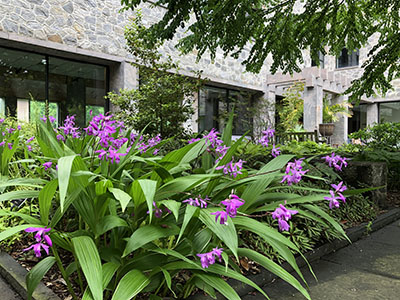
Spiraea media ‘SMSMBK’ (Blue Kazoo® spirea) is that great-looking yet minimal care plant. Cool blue foliage with reddish-purple highlights juxtaposes well with the bright white flowers. The deciduous shrub blooms over a long period of time attracting pollinators while not being overly tempting to deer. While the cultivar boasts ease of care, its multitude of garden applications make it all the more appealing. Possibilities include creating a low hedge, covering a bank or slope, or adding to a container for seasonal display. Two plants reside in the Terry Shane Teaching Garden. Photo credit: J. Coceano

The Swarthmore traffic roundabout is awash in blooms during May and June. Allium, Baptisia, and Salvia create a stunning display. While these larger plants easily grab one’s attention, other smaller, yet equally colorful plants, create a tapestry of low-growing, drought-tolerant varieties that happily inhabit the tough conditions found in island pockets between sidewalks and pedestrian crosswalks. One such plant is Phemeranthus calycinus (synonymous with Talinum calycinus). The Central United States native, known as fameflower, inhabits dry, rocky soils. Pink to red flowers are held atop leafless stems that rise from basal clumps of sparse, narrow, succulent-like leaves. The airy appearance partners well with the carpets of sedum planted around it, acting like a backdrop to highlight the flowers. The tough perennial is easy to grow so long as well-draining soil is provided. Photo credit: J. Coceano

For some, growing a plant with demanding cultural requirements is a challenge well accepted. Such plants conjure emotions ranging from fascination to frustration. The Orchid family is such an example. The exquisite diversity of flower forms results in much admiration. Only a few orchids are true perennials in our area. Of those, even fewer are readily available or easy to cultivate. One of the easiest is Bletilla striata, the Chinese ground orchid. The terrestrial orchid produces small, purple, cattleya-like flowers which emerge from corm-like pseudobulbs. Providing ideal cultural conditions, partial shade and consistent moisture, will promote naturalization over time. Several mature clumps can be seen in the Isabelle Cosby Courtyard. Photo credit: J. Coceano
